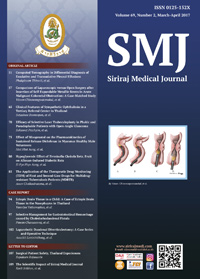Clinical Features of Sympathetic Ophthalmia in a Tertiary Referral Center in Thailand
Keywords:
Sympathetic ophthalmia, granulomatous, panuveitis, anterior uveitis, ocular injuryAbstract
Background: Sympathetic ophthalmia is a rare bilateral granulomatous intraocular inflammation, developed after ocular injury in one eye. If untreated, there is a potential risk of developing visual impairment in both eyes. An awareness of this disease is crucial. Studies related to clinical characteristics, treatment outcomes and disease complications would help us more understand more about the disease and visual prognosis.
Objective: To report clinical features of sympathetic ophthalmia and potential ocular complications of the disease.
Methods: This study was a descriptive retrospective study. Medical records of patients who were diagnosed with sympathetic ophthalmia at Siriraj Hospital between January 2006 and January 2015 were reviewed. Patient’s demographic data, history and details of ocular injuries or surgeries, details of ocular examinations, follow up duration and treatment outcomes were recorded.
Results: Twenty-three sympathetic ophthalmia patients were found. Eighteen patients (78.3%) had histories of ocular trauma and 5 patients (21.7%) had histories of ocular surgery. Duration between ocular injuries and onset of intraocular inflammation ranged from 24 days to 50 years. No associated risk factors of developing sympathetic ophthalmia were identified due to incomplete data and small sample size. The most common complication was secondary glaucoma. There were wide varieties of treatment regimen. Some patients were treated with only corticosteroid eye drops, whereas some patients were treated with systemic corticosteroids and/or immunosuppressive medications. Most patients (17/23; 74%) had visual improvement on their last visit.
Conclusion: Early diagnosis, early detection of disease complications and early initiation of proper treatments can alter disease prognosis and visual outcome in most patients.
Thai Clinical Trial Registry identification number TCTR20161028002
Downloads
Published
How to Cite
Issue
Section
License
Authors who publish with this journal agree to the following conditions:
Copyright Transfer
In submitting a manuscript, the authors acknowledge that the work will become the copyrighted property of Siriraj Medical Journal upon publication.
License
Articles are licensed under a Creative Commons Attribution-NonCommercial-NoDerivatives 4.0 International License (CC BY-NC-ND 4.0). This license allows for the sharing of the work for non-commercial purposes with proper attribution to the authors and the journal. However, it does not permit modifications or the creation of derivative works.
Sharing and Access
Authors are encouraged to share their article on their personal or institutional websites and through other non-commercial platforms. Doing so can increase readership and citations.











